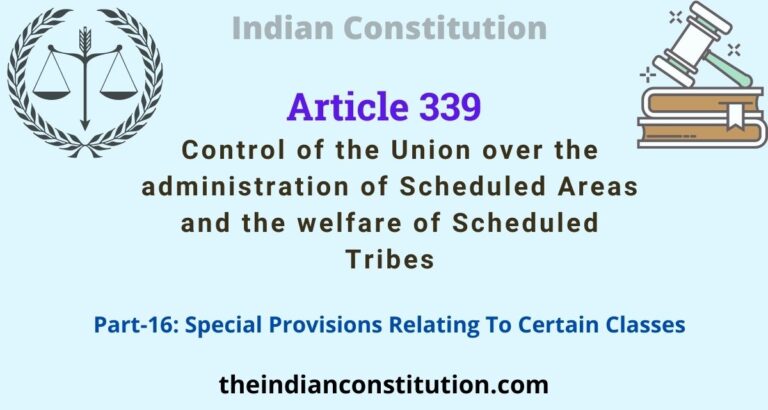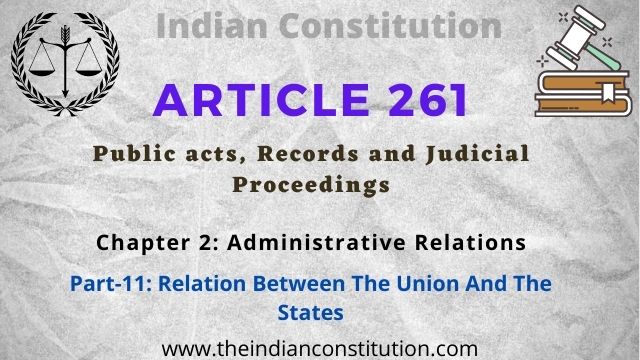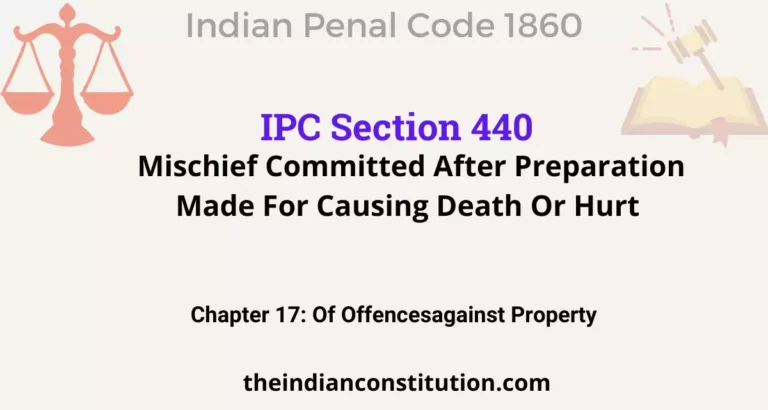Legislative Relations Between Centre And State
The Constitution of India, being federal in structure, divides all powers (legislative, executive and financial) between the Center and the States. However, there is no separation of judicial power as the Constitution has established a unified judicial system to enforce central laws as well as state laws.
Although the Center and the States are supreme in their respective fields, maximum harmony and coordination between them is necessary for the effective functioning of the federal system. Therefore, the Constitution contains detailed provisions to regulate various dimensions of the relationship between the Center and the States.
The Centre-state relations can be studied under three heads:
- Legislative relations.
- Administrative relations.
- Financial relations.
Legislative Relations
Articles 245 to 255 in Part XI of the Constitution deal with legislative relations between the Center and the States. Apart from these, there are some other articles related to the same topic.
Like any other federal constitution, the Indian Constitution also divides legislative powers between the Center and the States with respect to both territory and subjects of law.
In addition, the Constitution also provides for parliamentary legislation in state territory in five exceptional situations, as well as control by the Center over state legislation in certain cases. Thus, Centre-State legislative relations have four aspects, namely
- Territorial extent of Central and state legislation;
- Distribution of legislative subjects;
- Parliamentary legislation in the state field;
- Centre’s control over state legislation.
1. Territorial Extent of Central and State Legislation
The Constitution defines the territorial limits of the legislative powers vested in the Centre and the states in the following way:
(i) Parliament can make laws for the whole or any part of the territory of India. The territory of India includes the states, union territories, and certain other territories that are currently included in the territory of India.
(ii) A State legislature can make laws for the whole or any part of the State. Laws made by the State legislature do not apply outside the State, except when there is sufficient nexus between the State and the object.
(iii) Parliament alone can make ‘extra-territorial laws’. Thus, the laws of Parliament also apply to Indian citizens and their property in any part of the world.
However, the Constitution places some restrictions on the full territorial jurisdiction of Parliament. In other words, the laws of Parliament do not apply in the following areas:
(i) The President may make rules for the peace, progress, and good government of the four Union Territories of Andaman and Nicobar Islands, Lakshadweep, Dadra and Nagar Haveli and Daman and Diu. A regulation so made has the same force and effect as an Act of Parliament. It can also repeal or amend any Act of Parliament in relation to these Union Territories.
(ii) The Governor has the power to direct that any Act of Parliament shall not apply to any scheduled area of the State or shall not apply with specified modifications and exceptions.
(iii) The Governor of Assam may similarly direct that any Act of Parliament does not apply to the tribal area (autonomous district) of the State or does not apply with specified modifications and exceptions. The President has similar powers with respect of tribal areas (autonomous districts) in Meghalaya, Tripura, and Mizoram.
2. Distribution of Legislative Subjects
The Constitution provides for a three-fold distribution of legislative subjects between the Centre and the states, viz., List-I (the Union List), List-II (the State List) and List-III (the Concurrent List) in the Seventh Schedule:
(i) Parliament has exclusive powers to make laws with respect to any matter mentioned in the Union List. The list currently has 100 subjects (originally 97 subjects) such as defense, banking, foreign affairs, currency, nuclear energy, insurance, communications, inter-state trade and commerce, census, audit, etc.
(ii) The State Legislature has exclusive powers to make laws with respect to any matter listed in the State List “in ordinary circumstances”. It currently has 61 subjects (originally 662 subjects) such as public order, police, public health and sanitation, agriculture, prisons, local government, fisheries, markets, theatre, gambling, etc.
(iii) Both Parliament and State Legislature can make laws with respect to any matter listed in the Concurrent List. The list currently contains 52 subjects (originally 473 subjects) such as criminal law and procedure, civil procedure, marriage and divorce, population control and family planning, electricity, labor welfare, economic and social planning, medicines, newspapers, and books. and printing press, and others. The 42nd Amendment Act of 1976 transferred five subjects from the State List to the Concurrent List, namely, (a) Education, (b) Forests, (c) Weights and Measures, (d) Protection of wild animals and birds, and ( e) administration of justice; Constitution and organization of all courts except the Supreme Court and the High Court.
The power to make laws with respect to residuary subjects (i.e. matters not included in any of the three lists) is vested in Parliament. This residual power of law also includes the power to impose residual taxes.
It is clear from the above scheme that matters of national importance and matters which require uniformity of law across the country are included in the Union List. Matters of regional and local importance and those matters which permit diversity of interests are specified in the State List.
Matters on which uniformity of law throughout the country is desirable but not necessary are included in the Concurrent List. Thus, it allows uniformity as well as diversity.
In the US, the Constitution enumerates only the powers of the federal government and leaves residuary powers to the states. The Australian Constitution followed the American pattern of a single enumeration of powers. Canada, on the other hand, has dual counting—federal and provincial, and residuary powers are vested in the center.
The Government of India (GO) Act of 1935 provided for a threefold calculation, viz., federal, provincial and concurrent. The present Constitution follows the scheme of this Act but with one difference, that is, under this Act, the residuary powers were given neither to the federal legislature nor to the provincial legislature but to the Governor-General of India. In this regard, India follows the Canadian example.
The Constitution clearly ensures the primacy of the Union List over the State List and the Concurrent List over the State List. Thus, in case of overlapping between the Union List and the State List, the former should prevail. In case of overlapping between the Union List and the Concurrent List, again the former should prevail. Where there is a conflict between the Concurrent List and the State List, the former should prevail.
In case of conflict between the Central law and the State law on any subject included in the Concurrent List, the Central law prevails over the State law. But, there is one exception. If the law of a state has been reserved for the consideration of the President and his assent has been obtained, then the law of the state applies in that state. But, it will still be competent for Parliament to repeal such a law by later making law on the same matter.
3. Parliamentary Legislation in the State Field
The above scheme of distribution of legislative powers between the Center and the States is to be maintained even in normal times. But, in unusual times, the distribution plan is either modified or suspended. In other words, the Constitution empowers Parliament to make laws on any matter included in the State List in the following five exceptional circumstances:
When Rajya Sabha Passes a Resolution: If the Rajya Sabha declares that it is necessary in the national interest that the Parliament should make a law on any matter in the State List, the Parliament becomes competent to make a law on that matter. Such a motion must be supported by two-thirds of the members present and voting. This resolution remains in force for one year; It can be renewed any number of times but not for more than one year at a time. The laws cease to have effect at the expiration of six months from the date the resolution comes into force.
This provision does not restrict the power of a State legislature to make laws on the same matter. But, in case of inconsistency between the State law and the Parliamentary law, the latter shall prevail.
During a National Emergency: Parliament has the power to make laws with respect to matters in the State List while the declaration of national emergency is in force. The laws become inoperative at the expiration of six months after the end of the emergency.
Here also, the power of the State legislature to make laws on the same matter is not restricted. But, in case of disagreement between the State law and the Parliamentary law, the latter shall prevail.
When States Make a Request: When the Legislative Assemblies of two or more States pass a resolution requesting the Parliament to make a law on any matter in the State List, the Parliament can make a law to regulate that matter.
The law thus made applies only to those states which have passed the resolution. However, any other state can subsequently adopt it by passing a resolution to this effect in its legislature. Such law can be amended or repealed only by the Parliament and not by the legislatures of the respective states.
The effect of passing a resolution under the above provision is that Parliament becomes entitled to make laws with respect to a matter for which it has no power to make laws.
On the other hand, the state legislature ceases to have the power to make laws with respect to that matter. This resolution acts as a relinquishment or surrender of the power of the State legislature in relation to that matter and places it entirely in the hands of the Parliament which alone can make laws in relation to it.
Some examples of laws passed under the above provision are the Prize Competition Act, 1955; Wild Life (Protection) Act, 1972; Water (Prevention and Control of Pollution) Act, 1974; Urban Land (Ceiling and Regulation) Act, 1976; and Transplantation of Human Organs Act, 1994.
To Implement International Agreements: The Parliament can make laws on any matter in the State List for implementing international treaties, agreements, or conventions. This provision enables the Central government to fulfill its international obligations and commitments.
Some examples of laws enacted under the above provision are the United Nations (Privileges and Immunities) Act, 1947; Geneva Convention Act, 1960; Anti-Hijacking Act, 1982 and legislations relating to the environment and TRIPS.
During President’s Rule: When President’s rule is imposed in a state, the Parliament has the right to make laws on any matter in the State List relating to that state. The law made by the Parliament remains in force even after President’s rule. This means that the period for which such law remains in force does not end with the period of the President’s rule. But, such law can be repealed or changed or re-enacted by the state legislature.
4. Centre’s Control Over State Legislation
Besides the Parliament’s power to legislate directly on the state subjects under exceptional situations, the Constitution empowers the Centre to exercise control over the state’s legislative matters in the following ways:
(i) The Governor can reserve certain types of bills passed by the State Legislature for the consideration of the President. The President has complete veto power over them.
(ii) Bills on certain matters listed in the State List can be introduced in the State Legislature only with the prior approval of the President. (For example, bills restricting freedom of trade and commerce).
(iii) The President can direct the states to reserve money bills and other financial bills passed by the state legislature for his consideration during a financial emergency.
From the above, it is clear that the Constitution has assigned a position of superiority to the Center in the legislative field.
In this context, the Sarkaria Commission (1983–87) on Centre-State relations stated: “The rule of Union supremacy is a technique to avoid absurdities, resolve conflicts and ensure harmony between Union and State laws. If the Union This principle of supremacy is excluded, it is not difficult to imagine its harmful consequences. There is every possibility that our two-tier political system would be riven by interference, conflict, legal anarchy, and confusion caused by numerous conflicting laws. This will be a major casualty. The unity of the common citizen. Unified legislative policy and uniformity on basic issues of common Union-State concern will be disrupted. The federal principle of unity in diversity will be a major casualty. Therefore, federal supremacy. This rule is indispensable for the successful functioning of the federal system.”





